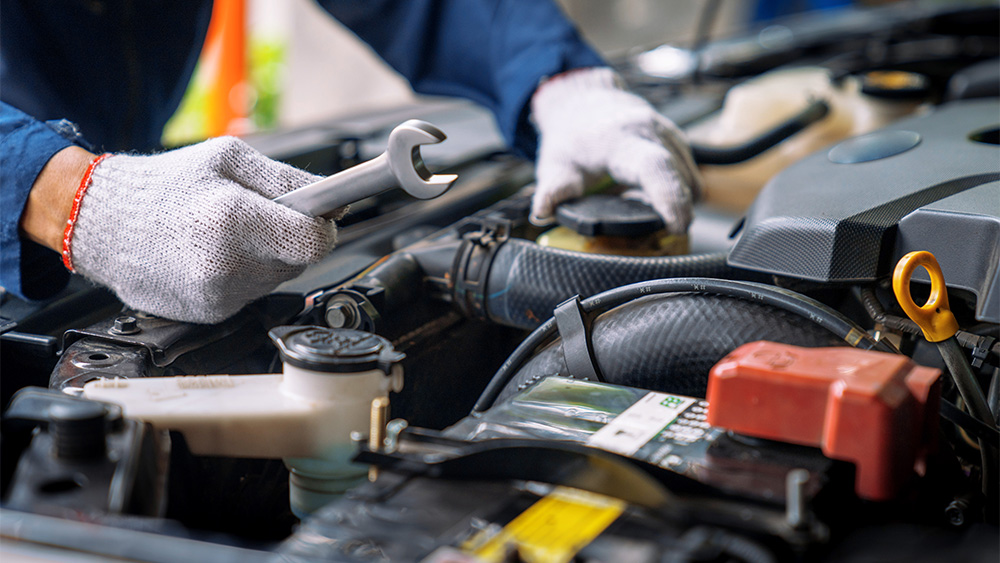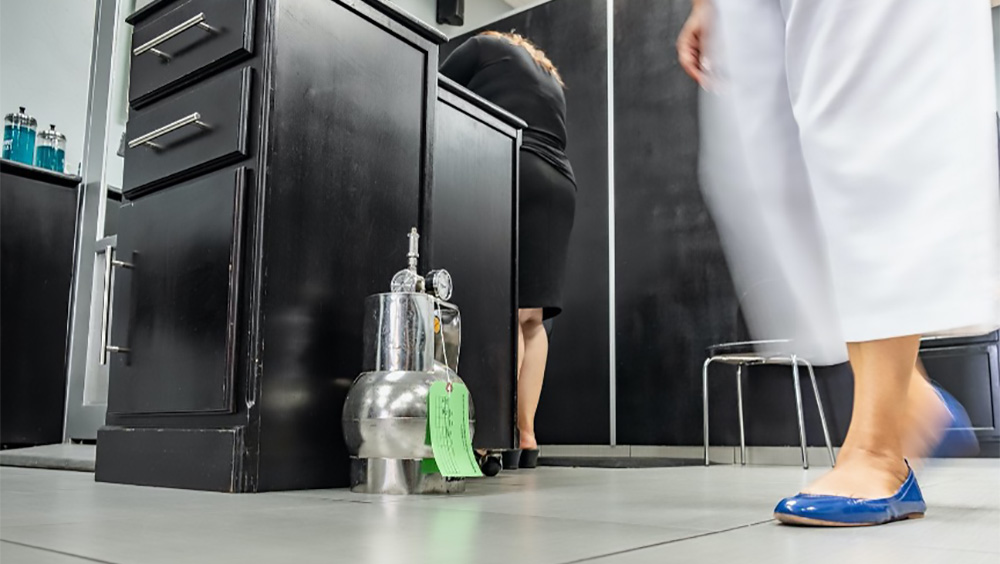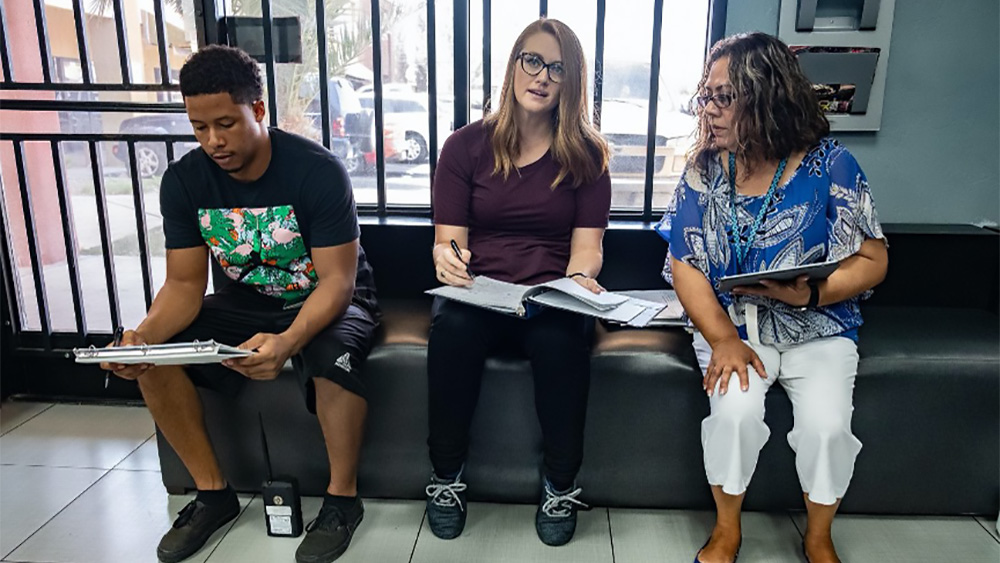Article Highlights
-
Workers in auto shops and beauty salons are disproportionately exposed to hazardous chemicals in the air.
- Latinos working in these small businesses in Arizona were impacted by the COVID-19 pandemic.
-
NIEHS supports a study to increase workplace safety in auto shops and beauty salons during the COVID-19 pandemic.
-
Community health workers share COVID-19 information with small businesses using virtual methods.
When the COVID-19 pandemic hit, environmental health researcher Paloma Beamer was in the middle of a multi-year research project with small businesses in Tucson, Arizona. A professor at the University of Arizona, Beamer saw firsthand how businesses struggled financially and communities collapsed due to the virus. Business owners had no idea what to do. “People kept calling us. ‘I work at this business, and somebody tested positive. Do I have to shut the whole business down? What do we do?’” Beamer said.
The pandemic derailed Beamer’s research on reducing the level of harmful chemicals that Latinos working in small businesses in Tucson breathe in every day. Social distancing halted visits to auto shops and beauty salons. Many businesses had to close to prevent the spread of the virus. Those that didn’t — like most auto shops — imposed strict limitations on who could go into them.
So the research team pivoted and took on a new responsibility: helping small businesses cope with the pandemic. “We wanted to make sure that they [the business owners and workers] felt that we were there for them, to provide them the help they needed,” said Flor Sandoval, Beamer’s partner in the research and the program director at the Sonora Environmental Research Institute (SERI), a local health care and research center.
With a grant from the National Institute of Environmental Health Sciences (NIEHS), the team investigated what businesses and their workers needed to know, then designed a virtual program that included online guidelines to navigate the COVID-19 emergency, social media campaigns, webinars, and group video chats where business owners discussed their doubts and thoughts with community health workers known as promotoras.

Supporting Small Businesses During COVID-19
Funded by NIEHS, the Sonora Environmental Research Institute developed and compiled useful materials to keep beauty salons and auto shops informed on COVID-19 testing, best practices, reopening, and more.

Beamer and the SERI team found that auto shops were not as significantly affected by the lockdowns as beauty salons in southern Tucson.

Beamer and the SERI team found that auto shops were not as significantly affected by the lockdowns as beauty salons in southern Tucson.
Navigating the Pandemic, One FAQ at a Time
The original project started in 2006, when community health workers from SERI were visiting families with children with asthma and other respiratory illnesses in southern Tucson. As they walked the streets of the mainly Latino neighborhoods, they noticed strong smells coming out of beauty salons and auto shops. SERI mapped all the beauty salons and auto shops that used products containing potentially hazardous chemicals called volatile organic compounds (VOCs). These chemicals are present in many everyday products, from paint to cleaning sprays, and are released into the air whenever the products are used. Evidence has linked VOCs to a variety of illnesses, including asthma, cancer, heart disease, and neurological issues such as Alzheimer’s disease, memory problems, and loss of hearing or smell.1-3
Beamer and the SERI team found that Tucson’s most vulnerable communities were at greater risk of being exposed to VOCs. In 2011, researchers found that about half of potential VOC emissions in the city were in ZIP codes where approximately 15% of Tucson’s population lived — and most of those people were from low-income minority populations. After working with hundreds of small businesses in these communities, researchers decided to focus on workers in beauty salons and auto shops, who likely suffered the worst exposure levels, as their work involves more VOCs.
In 2019, the group measured the levels of exposure to VOCs in 21 beauty salons and auto shops. “We were surprised by how high the levels were,” Beamer said. She knew that diseases and injuries linked to the workplace are a leading cause of death in the United States. More than 49,000 people die every year of illnesses attributable to their jobs.4 Most of those people are minorities and low-wage workers,5 like the mostly Latino workers at the beauty salons and auto shops in Tucson.
The pandemic, Beamer said, amplified those occupational risks. Businesses needed to increase cleaning and disinfection of their facilities, but it was harder to get cleaning supplies. This led many workers to resort to homemade sanitizers and whatever disinfectants they could find. At the same time, personal protective equipment (PPE), such as masks and gloves, was harder to access. That meant workers were more likely to be exposed to VOCs.
The workers at these small businesses were also at higher risk of exposure to SARS-CoV-2, the virus that causes COVID-19. The six Tucson ZIP codes involved in the study were some of the hardest hit by COVID-19. “These are people who are trying to earn money to support their families,” Beamer said. “So these have been the workers that have been most affected — and their families have been most affected — because they still have to go to work, and they’re bringing home the virus with them.”
That reality moved the research team to apply for new funding to help the struggling businesses. First, the team interviewed 21 owners and workers to assess the situation. They found that, as Sandoval put it, “There was a lot of fear from the community. There was a lack of information; they were just relying on the news,” to figure out what to do with their businesses.
The information that the team gained from the interviews helped them put together a telepromotora program that provided helpful resources to the businesses and started conversations with them using social media platforms like Facebook. The program includes a website in English and Spanish with informational resources and answers to frequently asked questions about safety in the workplace during the COVID-19 pandemic, testing, how to handle a positive test result, and, more recently, vaccination and the Delta variant. SERI also created a postcard mailed directly to some businesses to let them know about the website.
We wanted to make sure that [the business owners and workers] felt that we were there for them to provide the help they needed.” — Flor Sandoval, SERI Program Director

A Summa canister was used to collect air samples in beauty salons before the pandemic hit. Photo courtesy of Sonora Environmental Research Institute, Inc.

A Summa canister was used to collect air samples in beauty salons before the pandemic hit. Photo courtesy of Sonora Environmental Research Institute, Inc.
A Changing Environment
As the pandemic continues, the researchers are trying to understand its effect on these small businesses. Imelda Cortéz, SERI’s leading promotora, said that one of the saddest things is seeing that a few of the participants in their VOC research have had to shut down. “We’ve been calling them, and we get this message saying that their phone number is disconnected. We go to the store, and we see the ‘CLOSED’ sign,” she said.
Business owners are worried another surge will shut them down again, ending their businesses for good. “I worry the anti-vaccine movement will succeed in spreading misinformation and cause a reverse in the recovering economy,” one worker told a researcher. “We would not recover from another surge.”
The researchers also noticed that the pandemic hit beauty salons harder than auto shops, because Tucson classified auto shops as essential. A recent survey of 34 businesses in the area found that 94% of beauty salons in the sample closed, but only 18% of auto shops did.
As the team goes back into the field, they will incorporate this knowledge about COVID-19 into the possible solutions they present to business owners. For example, spray disinfectants give off more VOCs than wipes, but the survey showed that workers feel both are equally safe. “What we’ll try to do is to convince them to use wipes, which are safer,” Beamer said.
In the end, according to Beamer, both this research and the larger project that she is developing with these communities are about providing workers with the knowledge to empower themselves and to work safely. “Certain jobs have a higher risk of exposure to hazardous chemicals and hazardous agents like coronavirus, and [workers] may not have the knowledge or access to ways to protect themselves,” she says. “Whatever we can do to try to empower them is what I want to do.”
Sources
-
Mølhave, L., Clausen, G., Berglund, B., De Ceaurriz, J., Kettrup, A., Lindvall, T., Maroni, M., Pickering, A. C., Risse, U., Rothweiler, H., Seifert, B., & Younes, M. (1997). Total volatile organic compounds (TVOC) in indoor air quality investigations. Indoor Air, 7(4), 225–240. https://doi.org/10.1111/j.1600-0668.1997.00002.x
-
Triebig, G., & Hallermann, J. (2001). Survey of solvent related chronic encephalopathy as an occupational disease in European countries. Occupational and Environmental Medicine, 58(9), 575–581. http://dx.doi.org/10.1136/oem.58.9.575
-
Peplonska, B., Stewart, P., Szeszenia-Dąbrowska, N., Lissowska, J., Brinton, L. A., Gromiec, J. P., Brzeznicki, S., Yang, X. R., Sherman, M., García-Closas, M., & Blair, A. (2010). Occupational exposure to organic solvents and breast cancer in women. Occupational and Environmental Medicine, 67(11), 722–729. https://doi.org/10.1136/oem.2009.046557
-
Steenland, K., Burnett, C., Lalich, N., Ward, E., & Hurrell, J. (2003). Dying for work: the magnitude of US mortality from selected causes of death associated with occupation. American Journal of Industrial Medicine, 43(5), 461–482. https://doi.org/10.1002/ajim.10216
-
Steege, A. L., Baron, S. L., Marsh, S. M., Menéndez, C. C., & Myers, J. R. (2014). Examining occupational health and safety disparities using national data: A cause for continuing concern. American Journal of Industrial Medicine, 57(5), 527–538. https://doi.org/10.1002/ajim.22297
 An official website of the United States government
An official website of the United States government


